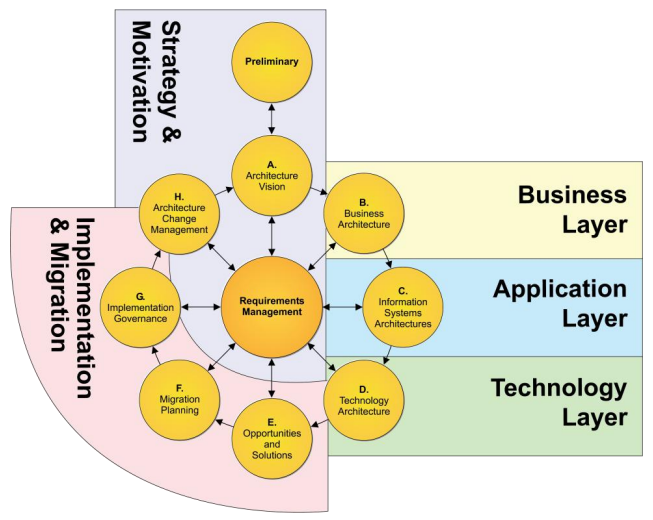Introduction
The integration of enterprise architecture frameworks is a key concern for organizations seeking comprehensive and cohesive solutions. Among the widely adopted frameworks, ArchiMate and TOGAF ADM stand out for their ability to provide a holistic view of enterprise architecture. In this article, we will explore the seamless mapping of the ArchiMate language onto the phases of the TOGAF Architecture Development Method (ADM) and delve into why this integration is instrumental for effective architecture development.
ArchiMate: A Brief Overview
The ArchiMate language serves as a powerful modeling tool, encompassing core layers such as Business, Application, and Technology. Beyond these layers, ArchiMate includes elements for strategy, motivation, and the implementation and migration of architectures. This versatility positions ArchiMate as a comprehensive language for describing the intricacies of enterprise architecture.
Mapping ArchiMate to TOGAF ADM Phases
Figure below illustrates a simplified mapping of ArchiMate onto the various phases of the TOGAF ADM. The Business, Application, and Technology Layers seamlessly align with the Business, Information Systems, and Technology Architecture domains defined by TOGAF. This alignment fosters a cohesive representation of an organization’s architecture, ensuring consistency and clarity across different domains.

Strategic Elements in ArchiMate
The strategy and motivation elements within the ArchiMate language play a pivotal role in supporting several key phases of the TOGAF ADM. During the Requirements Management, Preliminary, and Architecture Vision phases, these elements aid in establishing high-level business goals, architecture principles, and initial business requirements. Furthermore, their relevance extends to the Architecture Change Management phase, addressing the dynamic nature of changing requirements. While not explicitly shown in Figure 9, these elements can also find application in Phases B, C, and D, adding value throughout the entire architecture development process.
Implementation and Migration Support
ArchiMate’s implementation and migration elements seamlessly integrate with the Opportunities and Solutions, Migration Planning, and Implementation Governance phases of the TOGAF ADM. These elements provide a structured approach to implementing and evolving architectures, ensuring that organizations can adapt to changing needs and technological landscapes with efficiency and precision.
Why Seamless Integration Matters
The seamless integration of ArchiMate with TOGAF ADM offers several advantages to organizations navigating the complexities of enterprise architecture development. Firstly, it provides a unified language for communication and collaboration among stakeholders, fostering a shared understanding of architectural components and their interdependencies. This common language significantly reduces the risk of misinterpretation and ensures alignment with organizational goals.
Secondly, the integration allows for a more streamlined and efficient architecture development process. By leveraging ArchiMate’s rich modeling capabilities within the well-defined structure of the TOGAF ADM, organizations can navigate each phase with clarity and purpose. This alignment facilitates a smoother transition from strategic planning to implementation, enhancing the overall agility and responsiveness of the enterprise architecture.
Conclusion
The mapping of ArchiMate onto the TOGAF ADM presents a powerful solution for organizations seeking a comprehensive and integrated approach to enterprise architecture development. By seamlessly aligning ArchiMate’s versatile language with the structured phases of the TOGAF ADM, organizations can achieve clarity, consistency, and efficiency throughout the architecture development lifecycle. This seamless integration not only simplifies communication among stakeholders but also empowers organizations to adapt and thrive in the ever-evolving landscape of enterprise architecture.